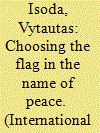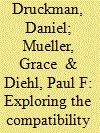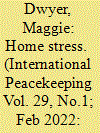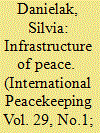|
|
|
Sort Order |
|
|
|
Items / Page
|
|
|
|
|
|
|
| Srl | Item |
| 1 |
ID:
186065


|
|
|
|
|
| Summary/Abstract |
The twenty-first century peacekeeping landscape is defined by the multiplicity of institutional frameworks under which international operations are deployed. Small states with limited resources cannot meet every demand for troop contributions and face the inevitable dilemma of choosing whose ‘flag’ to carry. For the first decade after joining NATO and the EU, the Baltic States gave a clear priority to NATO and U.S.-led military operations, but since the 2014 Ukrainian crisis gradually shifted their focus to the UN framework. Drawing on interviews with policy-makers in the three Baltic countries this article aims to explain this recent shift. It reviews the main theoretical assumptions about troop contributions to the UN peacekeeping operations and burden-sharing behaviour among NATO allies, and suggests that the recent troop deployment decisions of the Baltic States are best explained by a realist focus on national security concerns. The seemingly ‘internationalist’ context of UN peacekeeping operations simply happened to be most suitable for a bilateral exchange with their European allies, namely Germany and France, that in turn contributed troops to NATO's Baltic flank.
|
|
|
|
|
|
|
|
|
|
|
|
|
|
|
|
| 2 |
ID:
186071


|
|
|
|
|
| Summary/Abstract |
In their 2018 article, Diehl and Druckman address several hurdles that may hinder the effectiveness of multiple mission peace operations. One of these hurdles is the extent to which two or more missions are compatible. Based on the idea that similar missions have positively reinforcing effects, we propose alternative indicators of the compatibility concept in the context of nine types of UN missions conducted within the same peace operation. We code all missions in each of 70 UN peace operations (1948–2016) on twelve characteristics, such as whether the mission could be considered impartial or biased, whether it allows for an easy or hard exit, and coordination with IOs or the host government. A multidimensional scaling analysis is performed to evaluate the proximity of these missions: missions closer in proximity are regarded as being more compatible than those farther away. The proximity scores are used to develop the three compatibility indicators based on different theoretical logics. We then apply these indicators in some preliminary statistical analyses and also compare two peace operations with different compatibility characteristics to illustrate on-the-ground relevance of the indicators. Methodological issues concerning validity, next steps in the research, and policy implications are discussed.
|
|
|
|
|
|
|
|
|
|
|
|
|
|
|
|
| 3 |
ID:
186076


|
|
|
|
|
| Summary/Abstract |
Through the case of the Sierra Leonean deployment on the African Union Mission in Somalia (AMISOM), this study argues that family-related stress is an often-overlooked challenge in peacekeeping deployments. Using in-depth interviews with Sierra Leonean soldiers who were part of the deployment, military decision makers, and foreign advisors, this article lays out specific factors that created family-related tensions and contributed to lowered morale for Sierra Leonean peacekeepers. It demonstrates that the family-related stress on deployment is not only an issue of family separation, it is entangled with the historic trajectories of the armed forces and the sending country’s socio-economic conditions. The focus on Sierra Leone highlights the additional and unique burdens that soldiers and their families may endure in troop contributions from lower-income countries.
|
|
|
|
|
|
|
|
|
|
|
|
|
|
|
|
| 4 |
ID:
186075


|
|
|
|
|
| Summary/Abstract |
In the context of the current UN-led stabilization efforts in Mali, the United Nations peacekeeping mission undertakes significant investments in small-scale infrastructure development. The projects not only point to the spatial imprint of peacebuilding on the post-war landscape, but to the imagined performative power of infrastructure. Based on a survey of policy document and official communications, I investigate UN peacekeepers’ narratives of reconstruction, development, and peace promoted through this infrastructure building, and essentially, their role as urban planners in the context of the international military intervention. The account of peacebuilding through infrastructure projects and development resonates with the liberal peace paradigm but also problematizes the practice of civil–military intervention and its focus on infrastructure as device to achieving peace goals.
|
|
|
|
|
|
|
|
|
|
|
|
|
|
|
|
| 5 |
ID:
186064


|
|
|
|
|
| Summary/Abstract |
Disarmament, demobilization, and reintegration (DDR) processes will often dismantle the command-and-control structures of non-state armed groups (NSAGs) to prevent possible remobilization. Recent studies demonstrate that in some cases ex-combatant networks provide important social and economic support that hasten transitions to civilian life; however, this literature focuses exclusively on networks that emerge among commanders, peers, and foot soldiers. In this article, we broaden existing literature on ex-combatant networks by examining the role that family relations play in combatants’ war and post-war trajectory. Drawing on 18 life history interviews with former male combatants from the Lord’s Resistance Army (LRA) we argue that the familial can often be as influential as peer-relations. Specifically, our study shows that, first, familiies can shape the defection, demobilization, and reintegration processes of ex-combatants, and, second, ex-combatant networks can play an important role in facilitating the reunion of families in the aftermath of war. The endurance of familial relations forged within NSAGs pose important considerations to DDR policies.
|
|
|
|
|
|
|
|
|
|
|
|
|
|
|
|
| 6 |
ID:
186067


|
|
|
|
|
| Summary/Abstract |
The determinants of a country's UN peacekeeping troop contribution have been persistently studied. Trade, as a crucial self-interest motivation, is one of the important explanatory variables in the extant literature. However, the existing literature presents mixed results on the influence of trade on peacekeeping troop contributions. To capture the effect of trade on contributions precisely, we need to model expectations about future trade volume in a better way. Countries are pressured by the economic and political risks caused by the trade disruption and lobby groups to send peacekeeping troops to enable future trade or secure future investments. Therefore, trade potential, rather than realized trade, drives peacekeeping troop contributions. A gravity model is used to measure the trade potential between the UN peacekeeping mission countries and contributors, and test its relationship with the UN peacekeeping participation. Based on this measurement and a dyadic troop contribution dataset covering the period from 1990 to 2012, this article demonstrates that the counter-factual predictive trade volume is a relevant predictor of UN peacekeeping troop contributions.
|
|
|
|
|
|
|
|
|
|
|
|
|
|
|
|
|
|
|
|
|